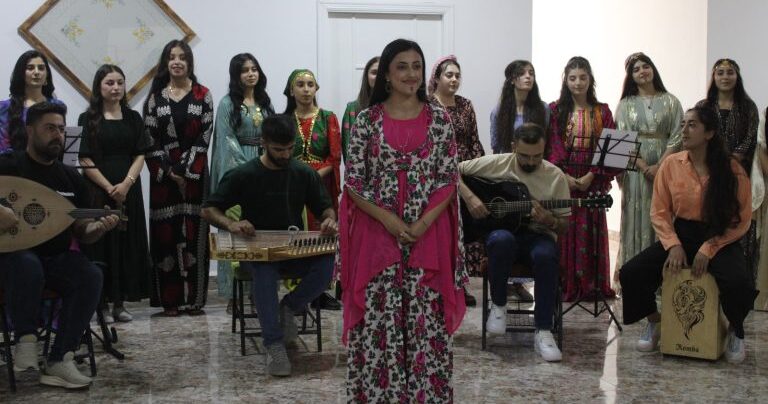Today in North and East Syria the art and culture movement has developed further, building the Women’s High University for Art and Culture. The university is based in Haseke and is part of Hilala Zerin, an autonomous women’s organisation for art and culture. This article explores the university’s role within Hilala Zerin and its impact on the broader mission of building a democratic society and women’s freedom.
In his writings, A. Ocalan presents culture on the basis of social identity and liberation and offers a deeper theoretical foundation for understanding why cultural institutions matter. In his defense texts, he writes: “In the case of society, we define culture in the narrow sense as the world of meaning, moral law, mentality, art and science of society. […] Once the institutions of a society are dismantled, one can no longer speak of its meaning, its culture in the narrow sense. In this case, the social institutions are like a bowl full of water. Once the bowl is broken, obviously, the existence of water cannot be mentioned. Even if it is mentioned, it is no longer water for the owner of the bowl, but an element of life that has flowed to the owners of other lands or vessels. The consequences of the loss of social meaning, mentality and aesthetics are even more grave. […] A society that has lost its mentality and aesthetic world is like a carcass left to rot, to be brutally torn apart and devoured. Therefore, in order to define a society culturally, it is absolutely necessary to evaluate it within its institutional and meaningful integrity.”
Ocalan’s words highlight the importance of rebuilding the cultural foundations of society, both through building social institutions and filling them with meaning. This idea finds practical expression in Hilala Zerin—‘Fertile Crescent’ in Kurdish—an umbrella organisation for women’s culture, linked to Kongra Star in North and East Syria. The name brings to mind the history of those areas: the Fertile Crescent is where, about 12,000 years ago, the Neolithic revolution began, under the leadership of women, contributing to key innovations such as language, agriculture, and the establishment of villages. During this revolution, both institutions and the meanings that filled them were created, forming the foundations of what we now understand as cultural and social identity.
Thanks to the work of women’s institutions like Hilala Zerin, the deeply historical role of women in shaping society in the revolution in North and East Syria is alive today. Mezgin Çolaka, coordinator of Hilala Zerin in North and East Syria, says: “Art and culture, including language and ethics, are the basis of society; together they define its identity. Women historically gave rise to the first societies, which were based on the cult and culture of the Mother Goddess. In patriarchal society, they have been fragmented and, in doing so, lost their role in defending culture and society.” Once again, the need to organise social institutions to address this fragmentation becomes clear—to revitalise culture and recover a collective identity, starting with women. “We want to revive the culture of the Mother Goddess and spread it throughout society. When culture was taken from the hands of women, it was distorted and placed in service of the patriarchal system. We must rediscover our culture—the culture of these lands—we want to rediscover who we are.”
Like water that, without a cup, is either dispersed or redirected to serve someone else, a crucial first step is to rebuild shattered social and cultural structures in order to fill them with meaning.
“Before the revolution, there were already art groups—both mixed and women’s—but it was in 2016 that we finally organised ourselves independently as women in North and East Syria. Within Hilala Zerin, we created different committees: for training, archives and journalism, diplomacy, and more. On the artistic side, we have sections for music, theatre, dance, and painting…” Today, Hilala Zerin is organised in every canton and major city. “We have also opened cultural centres for Arab culture in Tabqa, Raqqa, and Manbij, because in the project of the Democratic Nation every group should be able to express itself through its own culture.”
Since 2016, Hilala Zerin’s work has grown steadily. Today, there are 12 women’s music groups in North and East Syria, as well as theatre groups, musicals, and more. A major milestone in this growing cultural network was the founding of a high university to elevate this work. The Women’s High University for Art and Culture is the first of its kind in the world. Evîn Paşo, from the university administration, explains:
“The university opened on the 21st of November, 2024, and before that, we had been preparing for about three years. We opened it because we believe that the root of society’s problems is linked to women’s freedom. So, to solve the problems in society, you must first address the issues related to women. And if you want to spread culture in society, once again, you must start with women. Our history has been written with the feelings of women, with the lullabies of mothers for their children. The first musical note ever discovered was in a song written by a woman for a goddess. Later, this role was stolen from women: we want them to recover their role as the cultural vanguard.”
This university is not only a symbol of women’s cultural autonomy, but also a space where a new vision for society is actively taught and practiced. Its founding principles state:
“The university carries out its cultural and artistic activities with the understanding that ‘women’s freedom is the freedom of the whole society.’ […] It takes a leading role in changing sexist behaviour in society. […] It also develops its struggle against racism, religion, sexism, and scientism through cultural and artistic activities that promote the morality of freedom, the ideology of women’s liberation, and the system of democratic women’s confederalism.” Women and girls, mainly between the ages of 16 and 27, are admitted after passing an examination. The aim is to provide advanced training to those already experienced in their field.
There are four areas of training, each lasting three years:
• Music: individual and group lessons, choir, and instrumental. At the end, an orchestra will be formed as a symbol of the Democratic Nation of women.
• Theatre: In the first two years, lessons focus mainly on technique and theory, while in the final year, theatre groups will be formed.
• Cinema: Theoretical and practical courses in each related specialty; at the end, a short film will be produced.
• Sculpture and Fine Arts: In collaboration with the association of women sculptors and painters, students will showcase their work in exhibitions and displays at the end of the course.
“But,” explains Evîn, “our rules are flexible. It’s possible for a course planned for three years to be extended to four or even five years. The goal is to educate good artists.”
The anniversary of Mezgîn’s martyrdom was commemorated at the Women’s High University for Art and Culture in Haseke. Mezgîn, born Gurbet Aydın in 1962 in a village near Batman in Northern Kurdistan, joined the Kurdish liberation movement in 1980. She later moved to Europe to promote Kurdish culture, art and women’s freedom through her work. She was martyred in the mountains of Kurdistan on the 11th of May 1992. Her legacy, however, continues to inspire new generations of Kurdish women, and the development of art and culture in Kurdistan for many years.
During the commemoration, it wasn’t only Mezgîn who was remembered, but also all the martyrs who, through their sacrifice, made this revolution possible. Many of them were singers, dancers, or talented actors. In fact, to be a true revolutionary, you must also be an artist—and a real artist is also a revolutionary, because they shape society.
At the end of the commemoration, Evîn shared her feelings with us:
“When I went to university, everything was very cold. The goal of the education system wasn’t to shape personalities capable of building society—it was just to memorise information to pass exams. But here, the aim is to form people who can play a meaningful role in society. At the beginning, I felt a great sense of responsibility. I had to play a role in the lives of 46 women, and I was a bit afraid. But after three months, when I saw the results, I realized that we really can create change.
Today, I know that joyful and beautiful days lie ahead for women, and this will happen thanks to the future artists who will be educated in this university. And this is not only for Kurdish women, or for the women of Mesopotamia, Syria, or the Middle East—but for all the women of the world.”

